2008 Harley-Davidson Models - Motorcycle.com
"Ho hum. What to do?" is what I imagine the team of Harley-Davidson designers, engineers and management were asking themselves when planning for yet another year of motorcycles.
At this point in Harley's history they must start to feel like there's nothing new under the sun. It can't be easy after 105 years. Whether you're a Harley fan or not, one thing you can't do is underestimate a company that's been around that long.
So what did they do for year 1-0-5? Squeezed out three (two, really, as one is a slight variation on the same theme) new models from existing platforms, that's all.
Along with the expected new paint schemes, injection of chrome-a-licious accessories and a refresher on models recently released (Sportster Nightster as a late '07 and '08 CVOs) it was time to introduce the world to the Fat Bob, Rocker and Rocker C.
Fat Bob is the latest chunky-tired Dyna, formerly called the FXDF.
Now sixth in the family whose name begins with FXD, the Fat Bob brings some unique styling to the team, but ol' Bob carries the family genes in its ticker. The air-cooled, rubber-mounted, fuel-injected, Twin Cam 96 engine with a bore and stroke of 3.75 in. x 4.38 in. squeezing out a compression ratio of 9.2:1 that's good for a claimed 92 foot-pounds of torque at 3,000 rpm is what all Dynas use; including the Fat Bob.
The Fat Bob's 29-degree steering angle doesn't elicit the notion of razor sharp handling, however, it does boast the shortest wheelbase in the Dyna line at 63.7-inches. Combine that with just under five inches of ground clearance and a pair of 16-inch wheels and what you get is sporty-for-a-cruiser handling. Initial steering responses are a touch slow because of the chubby 130/90 tire up front, but once you've started the turn that same tire allows your confidence to grow as the bike continues to lean. Pushing all the way to the 4.92 inches of ground clearance and beyond was cake, and never once did I feel I had reached the limits imposed by the bike’s geometry. I often wished I could lean further as each new turn approached.
Slowing the Bob is the job of twin disc brakes up front and the ubiquitous single disc out back. Although pressure at the hand lever is transmitted through braided stainless steel lines, they still felt a bit numb and underpowered. A strong pull at the brake lever would ultimately result in a decent stop, but that's a little more than I care to apply to haul any bike down. Regardless of my performance-driven whining, the brakes were typical Harley in that they were sufficient but not great.
Conversely, application at the clutch lever was a welcomed light and easy feeling (there's gotta be a song in there somewhere). The six-speed transmission also offered familiar sensations expected from modern Harley trannies: a solid thunk and the impression that it'll last forever.
Speaking of comfort, Harley's has a winner with the cushy, sculpted saddle on this newest Dyna.
Another notable element of design and function are the drag-style bars with a mild V bend. These aggressive handlebars are joined to the top triple-clamp via its integrated riser. It creates a tough look, but not so tough that you can't enjoy the benefits of the rubber-mount. The bars grant good leverage for steering and do a good job of creating the rider triangle.
Speaking of comfort, Harley's has a winner with the cushy, sculpted saddle on this newest Dyna. At first sitting I was afraid that it was too soft and mushy. But at the end of two days of riding through the lush and beautiful rolling farmland just outside of Baltimore and neighboring Pennsylvania I was happy to dismiss my presumptions about the seat. It remained all-day long comfy.
The look is clean and simple without looking Spartan. Its slash-cut double-barrel 2-1-2 shotgun exhaust is a good example of how this bike differs from its siblings without doing so at risk of being labeled some kind of insecure middle child. "Hey! Look at me... See how different I am!" is not how the Bob seeks approval. It does so by marrying its unique, understated appearance with a good motor and good handling. Despite the dearth of serious twists and turns in this part of Maryland, the few I was able to carve up whilst on Fat Bob had me thinking that this bike was one of the most fun Harleys I've ridden to date. I hope Fat Bob doesn't go on a diet. The FXDF Fat Bob has an MSRP of $14,795.
Party Time!When you've been around as long as Harley has, celebrating your 105th birthday in big fashion is as natural as ass-less chaps at Sturgis.The Ride Home, as it's being called, is the largest Harley ride ever according to H-D, and serves as a pilgrimage to celebrate another milestone for The Motor Company. With 105 designated starting points that join up to any one of 25 different ride routes (with 80 additional start points along the way), all roads lead to Milwaukee.
The official ride starts August 17 through 27, 2008 and culminates in a four-day blowout in Milwaukee on August 28th. Along with the usual nightly parties, Main Street exhibition area, kickoff party, demo rides, fireworks and so on, attendees can look forward to a 105th parade (alleged to have over 7,500 bikes), a two-day Harley music and motorcycle festival, H.O.G.'s 25-anniversary celebration and activities at the new Harley-Davidson Museum which is expected to be open in time for the event.
A perennial favorite, the Softail model line picks up two more players this year with the Rocker and Rocker C. Essentially they're the same basic bike save for a more custom look and a very trick feature found on the C model.
The Softail line utilizes the air-cooled, fuel-injected, Twin Cam 96B (B for balanced) powerplant with a six-speed tranny. Though the engine is basically the same as that found in the Dyna line, it isn't rubber-mounted like the Dynas. Rigid engine mounting emulates the pseudo hardtail swingarm/frame combo that so many hardtails are defined by. Thankfully there's a perfectly good shock absorber with 3.4 inches of travel tucked so far out of sight that finding it requires crawling on your belly just to get a glimpse of it.
But what makes a Rocker a Rocker? Before you go out and buy one expecting to join Vince Neil on stage when the Motley Crue reunion tour comes to town, think before you buy. The Rocker name has nothing to do with your second career and everything to do with how that gloriously big rear fender hugs and – believe it or not – moves or rocks with the 240-section rear tire and swingarm.
How did they do it?
The first step was to make a strong fender, one made from bonded construction rather than a typical sheet metal piece. The next step is to move away from the conventional frame-mount point. The Rocker's rear fender is actually joined to the swingarm via a cantilever mount. The end result is a fender that moves in unison with the tire as the swinger travels up and down. Riding alongside a Rocker and seeing the fender in action is a treat.
But the effort wasn't purely fashionable. Harley engineers purport there to be over 100 Gs of force acting on a traditional cruiser or rigid frame chopper's rear fender. That can spell disaster for the welds holding it to the frame. With the Rocker design, broken or cracked mounts are no longer a concern.
Seen earlier this year on the Sportster Nightster, integrated LED turn signal/brake lights are also on the Rocker and Rocker C. Note the profile of the adjustable "V" handlebars. The bars put the rider's arms close to parallel with the ground and allow good steering leverage. What you're not seeing on the bars is switch gear wiring that's routed internally through the bars.
I made mention of the mandatory-for-a-custom-look 240-series rear tire and how it interacts with the fender. What I didn't mention was how such a big rear tire had little impact on the good handling of the bike. With a 19 x 2.15 tire wrapped around a five-spoke painted (or polished on the C) cast-aluminum spinner up front, I expected some pretty crummy handling. Nope, not here. Turn in is quick and handling is light and responsive. Hurray! The only drawback is the limited ground clearance. Here a scrape, there a scrape, everywhere a scrape, scrape.
H-D New TechTo share the love, some non-CVO Harley's can be had with the same tech. All touring bikes will get throttle by wire, and as a factory-installed option you can order ABS and/or cruise control. But the tourers don't get to hog up all the new stuff. Again, as a factory-installed option, you can order up any of the three VRSC bikes with the new ABS.
And here it is installed on a bike. That black ring sandwiched between the fork tube and brake rotor is all you'll ever see exposed of the ABS system. Clean.
The C model is the more custom-ified of the two, with plenty of chrome on the headlamp, triple clamps, handlebar riser, fork lowers, tank console, speedometer and polished cast- aluminum wheels. The paint is a bit more special, too, with flame pinstriping front to back. Additionally, the finned oil tank and swingarm are color matched to the frame where on the regular Rocker those two items have a "satin stainless metallic powdercoat."
So what's left to talk about? It's what you can't see on the Rocker C that makes it special. More than just chrome and paint, the C hides a secret. A secret that, depending on your station in life, may be the ticket that either keeps your mate happy or gets you a mate to begin with.
Tucked completely out of sight and under the rider seat is a simple pillion that attaches lickity split and hovers precariously over the rear fender. Called the Trick seat (yes, it's already trademarked), this sneaky saddle requires no tools and only takes about one minute to attach, worse case scenario. It goes a little something like this: Lift the rider saddle, pull out the rider seat pad, pull up and out on the strut, slip it into a groove, pop the rider pad on its perch and lock it into place with a slide pin. Voila! Instant chick getter.
This tiny pillion was about the only thing to create a perceptible ride difference between the two Rockers. The difference being how the rider (driver) sits on the saddle when the Trick seat is tucked away out of sight. Though they share the same saddle, the version on the C causes the rider to sit a bit taller thanks to the necessary clearance needed under the seat for the hidden passenger mount. Handling isn't affected, but the sensation is that you sit higher on the C. Start with and stay on the same bike and you'll never know any different.
I haven't ridden all the custom or custom-like cruisers out there, but I've ridden enough to know that the Rockers pull off what so many can't – combining look, sound and feel with actual riding performance and a reasonable level of comfort. Rock on!
The Rocker has an MSRP of $17,295; the Rocker C has an MSRP of $19,495.
What's New With Rest of '08:More by Pete Brissette




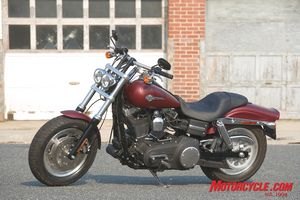




















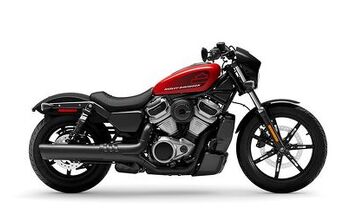
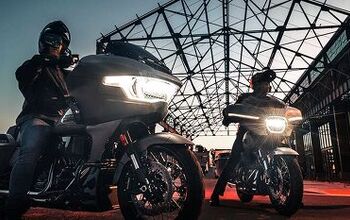
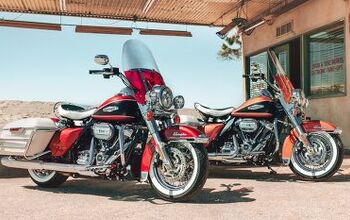
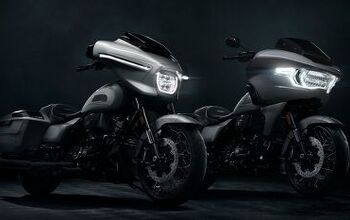
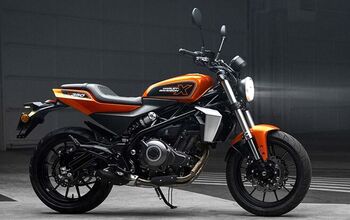












Comments
Join the conversation